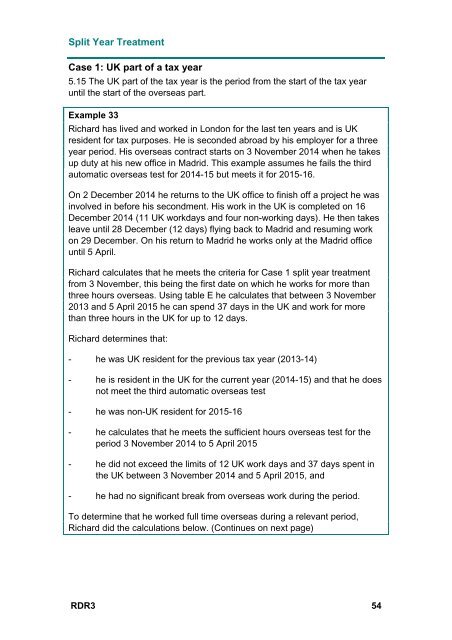Statutory Residence Test - HM Revenue & Customs
Statutory Residence Test - HM Revenue & Customs
Statutory Residence Test - HM Revenue & Customs
You also want an ePaper? Increase the reach of your titles
YUMPU automatically turns print PDFs into web optimized ePapers that Google loves.
Split Year Treatment<br />
Case 1: UK part of a tax year<br />
5.15 The UK part of the tax year is the period from the start of the tax year<br />
until the start of the overseas part.<br />
Example 33<br />
Richard has lived and worked in London for the last ten years and is UK<br />
resident for tax purposes. He is seconded abroad by his employer for a three<br />
year period. His overseas contract starts on 3 November 2014 when he takes<br />
up duty at his new office in Madrid. This example assumes he fails the third<br />
automatic overseas test for 2014-15 but meets it for 2015-16.<br />
On 2 December 2014 he returns to the UK office to finish off a project he was<br />
involved in before his secondment. His work in the UK is completed on 16<br />
December 2014 (11 UK workdays and four non-working days). He then takes<br />
leave until 28 December (12 days) flying back to Madrid and resuming work<br />
on 29 December. On his return to Madrid he works only at the Madrid office<br />
until 5 April.<br />
Richard calculates that he meets the criteria for Case 1 split year treatment<br />
from 3 November, this being the first date on which he works for more than<br />
three hours overseas. Using table E he calculates that between 3 November<br />
2013 and 5 April 2015 he can spend 37 days in the UK and work for more<br />
than three hours in the UK for up to 12 days.<br />
Richard determines that:<br />
- he was UK resident for the previous tax year (2013-14)<br />
- he is resident in the UK for the current year (2014-15) and that he does<br />
not meet the third automatic overseas test<br />
- he was non-UK resident for 2015-16<br />
- he calculates that he meets the sufficient hours overseas test for the<br />
period 3 November 2014 to 5 April 2015<br />
- he did not exceed the limits of 12 UK work days and 37 days spent in<br />
the UK between 3 November 2014 and 5 April 2015, and<br />
- he had no significant break from overseas work during the period.<br />
To determine that he worked full time overseas during a relevant period,<br />
Richard did the calculations below. (Continues on next page)<br />
RDR3 54
















